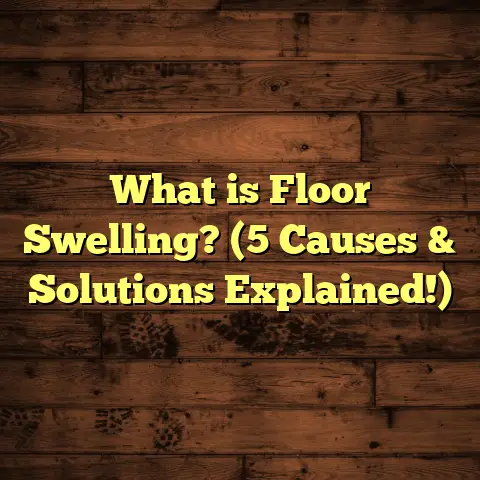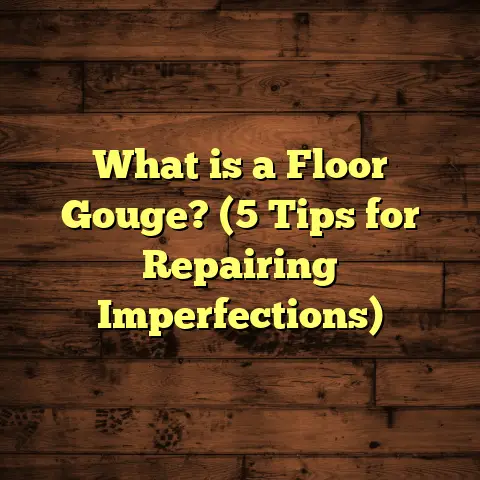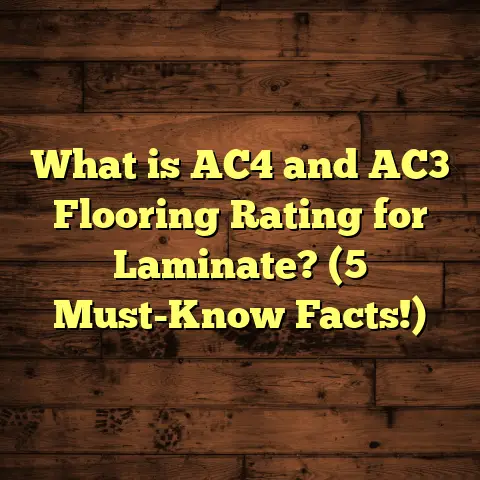What is Tile Adhesive? (5 Essential Types You Must Know)
You ever notice how people get super excited about picking tile colors and patterns but totally forget about what actually keeps those tiles glued down? I remember when I first started in flooring; I thought tile adhesive was just some generic glue you could grab off any shelf. Boy, was I wrong. The wrong adhesive can turn your beautiful new floor into a nightmare.
So, what exactly is tile adhesive, and why should you care? Let’s talk about that.
What Is Tile Adhesive?
Tile adhesive is the bonding agent that attaches your tiles to floors or walls. Think of it as the unsung hero behind every smooth, sturdy tiled surface you’ve ever admired. Without it, tiles would be loose, cracked, or worst of all, falling off.
Unlike regular household glues, tile adhesives are specially formulated to handle weight, pressure, moisture, and temperature changes. They have to create a strong bond between the tile and the substrate — which could be concrete, wood, drywall, or even metal.
When I first started laying tiles, I learned the hard way that not all adhesives are made equal. One project involved a kitchen floor where the tile kept popping loose. After some digging, I realized the adhesive was not suitable for the damp environment and heavy foot traffic. Switching to the right adhesive solved the problem immediately.
Tile adhesive can come in powder form (that you mix with water), ready-mixed paste, or even resin-based liquids. Each type has its pros and cons depending on your project’s needs.
Here’s a quick fact: according to a report by the Tile Council of North America (TCNA), about 60% of tile installation failures are due to improper adhesive choice or application. That blew me away when I first heard it. It shows how critical this stuff really is.
Now, let me walk you through the five essential types of tile adhesives that everyone should know about.
1. Cement-Based Adhesive: The Classic Workhorse
Cement-based adhesives are probably what most people think of when they hear “tile adhesive.” It’s a powder—mostly Portland cement combined with additives—that you mix with water to create a paste.
Why Choose Cement-Based Adhesive?
I’ve used this type on countless projects from bathroom walls to kitchen floors. It’s reliable, cost-effective, and works well with a variety of tiles like ceramic, porcelain, and natural stone.
One time I was hired to renovate a large commercial lobby with porcelain tiles. Cement-based adhesive did the job perfectly — strong enough to withstand heavy foot traffic and easy enough to spread evenly over large areas.
How Does It Work?
The cement powder reacts with water in a process called hydration. This forms crystals that interlock and harden over time, creating a durable bond between tile and surface.
Important: The surface must be clean, dry, and stable before applying. Moisture can weaken the bond if not addressed properly.
Strength & Curing Time
Cement-based adhesives typically take 24-48 hours to cure fully. During this time, avoid walking on or disturbing the tiles.
From my experience, rushing this step is one of the biggest reasons for tile failures. Patience pays off.
Limitations
Cement adhesives aren’t very flexible. So if your floor or wall experiences movement (like in wooden subfloors or areas with temperature swings), cracks can appear over time.
For these cases, other adhesives like polymer-modified types are better suited.
2. Epoxy Adhesive: The Heavy-Duty Solution
Epoxy adhesives are a game changer when it comes to durability and chemical resistance. They’re made by mixing resin and hardener components that chemically react to create a tough bond.
Where Epoxy Shines
I used epoxy adhesives for an industrial warehouse where harsh chemicals and heavy machinery were daily realities. Tiles needed to resist spills, impacts, and temperature extremes — epoxy nailed it.
Epoxy also works great for outdoor applications where moisture and freeze-thaw cycles can cause problems with other adhesives.
Application Challenges
Epoxy adhesives have a shorter working time — usually under an hour once mixed. You have to be fast and precise when spreading them.
Also, epoxy tends to be pricier than cement-based options.
Performance Stats
According to manufacturer data, epoxy bonds can be up to 10 times stronger than traditional cement adhesives and offer near-total resistance to water and chemical damage.
That strength makes epoxy a top choice for places like swimming pools, kitchens, garages, and factories.
My Experience With Epoxy
I remember a client who wanted a high-end kitchen with marble tiles. We chose epoxy because of its stain resistance and waterproof qualities. Years later, those tiles still look flawless despite daily cooking messes.
3. Polymer-Modified Adhesive: The Flexible Friend
Polymer-modified adhesives mix traditional cement powder with synthetic polymers (think latex or acrylic). These polymers improve adhesion strength and flexibility.
Why Flexibility Matters
Floors can expand or contract due to temperature changes or slight building movements. Rigid adhesives crack under stress; flexible ones bend slightly without breaking the bond.
On one project renovating a sunroom with radiant heating underfloor systems, polymer-modified adhesive was essential. The floor heated up and cooled down multiple times a day — only flexible adhesive kept the tiles intact.
Application Tips
They’re applied similarly to cement-based adhesives but offer improved workability and longer open time (time before they start setting).
Data Insight
Research shows polymer-modified adhesives improve bond strength by 20-40% compared to standard cement mixes. They also resist water penetration better — reducing risks of mold or tile lifting from moisture damage.
4. Ready-Mixed Adhesive: Convenience in a Bucket
Ready-mixed adhesives come pre-mixed in buckets—usually water-based pastes that are easy to apply without measuring powders or mixing liquids.
When To Use Ready-Mixed Adhesives
I often recommend these for small wall projects like kitchen backsplashes or bathroom walls where heavy traffic isn’t an issue.
They’re great for DIYers because they’re simple: open the bucket, spread with a trowel, stick on your tiles.
Limitations
Ready-mixed adhesives don’t have the same bonding power or durability as cement-based or epoxy types. For floors or outdoor areas subject to wear or moisture, they’re not suitable.
A client once tried ready-mixed adhesive on a bathroom floor to save money. Within months, several tiles lifted — costing more in repairs than if we’d used proper adhesive from the start.
5. Anaerobic Adhesive: A Specialist’s Choice
Anaerobic adhesives cure (harden) only in the absence of air and are mostly used in industrial applications involving metal or glass tiles where conventional adhesives struggle.
Where You’ll Find Anaerobic Adhesives
I’ve used them on specialty glass mosaics and metal-tile installations where smooth surfaces need strong bonds without messy curing times.
They’re less common for typical home projects but excellent for artistic or structural tiling requiring precision and toughness.
Personal Stories from the Field
Let me share some real-world experiences that highlight why knowing your adhesives matters:
- The Bathroom Disaster: Early in my career, I helped a homeowner install ceramic tiles in their bathroom using standard cement adhesive on an old wooden subfloor without polymer modification. Within six months, tiles cracked due to floor movement — we had to redo the entire floor with polymer-modified adhesive.
- Outdoor Patio Success: On an outdoor patio I worked on recently, we used epoxy adhesive because of frequent rain and temperature swings. That choice saved the client thousands in future repairs; no cracked or loose tiles even after two winters.
- Commercial Kitchen Challenge: A local restaurant needed new flooring resistant to chemical spills from cleaning agents. Epoxy adhesive was our go-to for its chemical resistance — no issues since installation three years ago.
- DIY Gone Wrong: A friend tried ready-mixed adhesive for her kitchen backsplash without checking surface prep properly; some tiles came off within weeks. After helping her fix it with proper prep and cement-based adhesive mixed with polymers, she was thrilled with how solid it felt.
These stories remind me that tile adhesive isn’t just technical jargon—it’s the foundation of every successful tiling project.
Understanding Surface Preparation and Its Role
No matter how good your tile adhesive is, if your surface isn’t prepared properly, you’ll face problems down the road.
What Does Proper Surface Prep Involve?
- Cleaning dirt, dust, grease
- Repairing cracks or holes
- Ensuring the surface is level
- Checking moisture levels especially on concrete slabs
- Using primers if required for porous surfaces
I always tell clients: “The secret to lasting tile installation isn’t just the glue—it’s what you’re gluing onto.”
One case involved installing tiles over an old vinyl floor without proper prep; adhesive didn’t bond well leading to bubbling tiles after a few months.
How Much Tile Adhesive Do You Need?
Calculating how much adhesive you need can be tricky but is crucial to avoid waste or shortages during installation.
Here’s a rough guideline:
| Tile Size | Trowel Size | Adhesive Consumption (kg/m²) |
|---|---|---|
| Small mosaic | 3×3 mm | 1–2 |
| Standard ceramic | 6×6 mm | 2–3 |
| Large format | 10×10 mm | 3–4 |
These numbers vary depending on substrate porosity and adhesive type.
To make life easier—and avoid costly errors—I use FloorTally for every project now. It factors in my exact tile size, surface area, chosen adhesive type, and even waste percentage from cutting and misapplication.
FloorTally’s estimates help me order just enough materials so there’s minimal leftover but no risk of running out mid-job. That saves trips to stores and extra expenses—trust me on this one!
Environmental Factors Affecting Adhesive Choice
Where you install matters as much as what you install.
- Indoor vs Outdoor: Outdoor installations face rain, UV rays, freeze-thaw cycles—epoxy or polymer-modified are best.
- Wet Areas: Bathrooms or pools require waterproof adhesives like epoxy.
- Heavy Traffic Zones: Commercial floors need strong bonds — epoxy or high-grade cement-based adhesives.
- Substrate Type: Wood floors need flexible polymer-modified adhesives; concrete slabs can use standard cement adhesives if dry.
Ignoring these factors is one reason installations fail prematurely.
How to Apply Tile Adhesive Like a Pro
Applying tile adhesive is an art as much as science:
- Mix Properly: Follow manufacturer instructions closely—too much water weakens bond; too little makes it hard to spread.
- Use Correct Trowel: Size affects thickness of adhesive layer and coverage.
- Spread Evenly: Avoid lumps that cause uneven tile placement.
- Work in Small Sections: So adhesive doesn’t dry before tiles go down.
- Press Tiles Firmly: To ensure good contact but don’t slide around.
- Clean Excess Immediately: Dried residue is tough to remove.
- Allow Proper Curing Time: Patience here pays off big time.
I always recommend practicing on scrap pieces before tackling real jobs—especially if it’s your first time working with epoxy or polymer-modified types.
Troubleshooting Common Issues with Tile Adhesive
Even pros encounter problems sometimes:
- Tiles Lifting: Often due to poor surface prep or using wrong adhesive.
- Cracking Tiles: Subfloor movement combined with rigid adhesive.
- Adhesive Stains on Tiles: Clean excess immediately; some adhesives stain porous tiles if left too long.
- Slow Setting: Cold temperatures can delay curing times.
Whenever something goes wrong, start by checking your substrate prep and adhesive choice first.
Final Thoughts About Choosing Tile Adhesive
If you take away one thing from this long chat: pick your tile adhesive like you pick your tiles—with care!
Think about:
- What kind of tile you have
- Where you’re installing it
- Environmental conditions
- Substrate material
- Your budget & skill level
Don’t skimp on this step; it affects everything from durability to appearance over time.
And if you want help estimating costs or figuring out material needs? Tools like FloorTally make my life easier every day by giving accurate numbers based on real local prices—not just guesses.
Feel free to ask me questions about specific projects or unusual situations—I love talking shop!





